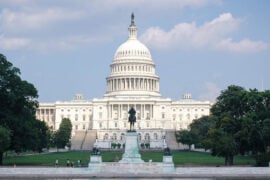In brief
After months of partisan bickering and Senate inaction, Congress finally passed another round of COVID-19 relief legislation as part of the Consolidated Appropriations Act, 2021, P.L. 116-260, (“CAA”), which was signed into law on December 27, 2020. We provide a summary of the tax-related CAA provisions and key modifications to the Paycheck Protection Program (“PPP”), before discussing President Biden’s tax agenda for 2021. The CAA’s tax provisions focus primarily on providing economic relief to taxpayers by expanding provisions of the Coronavirus Aid, Relief, and Economic Security Act (“CARES Act”) and renewing extenders.
To refer to our initial analysis of the CARES Act, see our prior client alert, available here.
How Do You Spell Relief? C-A-A
After months of partisan bickering and Senate inaction, Congress finally passed another round of COVID-19 relief legislation as part of the Consolidated Appropriations Act, 2021, P.L. 116-260, (“CAA”), which was signed into law on December 27, 2020. We provide a summary of the tax-related CAA provisions and key modifications to the Paycheck Protection Program (“PPP”), before discussing President Biden’s tax agenda for 2021. The CAA’s tax provisions focus primarily on providing economic relief to taxpayers by expanding provisions of the Coronavirus Aid, Relief, and Economic Security Act (“CARES Act”) and renewing extenders.
To refer to our initial analysis of the CARES Act, see our prior client alert, available here .
Employee Retention Credit Update
Under the CAA, the Employee Retention Credit (“ERC”) was updated to provide enhanced and extended benefits and to expand those employers that would qualify for the credit, beyond what was provided in the CARES Act.
By way of background, the ERC as enacted in the CARES Act, previously provided eligible employers with a refundable payroll tax credit of up to 50% of the first $10,000 of “qualified wages” paid to each employee during the period ranging from March 13, 2020 through December 31, 2020, or up to $5,000 in credit per employee for that period. For large employers, meaning employers with 100 or more employees, qualified wages generally were wages paid to employees when the employees were not providing services due to
COVID-19-related circumstances.
Extended Availability & Increased Credit Amount
The CAA extends the period for claiming the credit, increases the amount of credit available to eligible employers, and changes the periods for determining the credit. More precisely, the CAA extends the availability of the ERC for qualified wages paid until June 30, 2021 (instead of its prior expiration date of December 31, 2020), and increases the amount of credit available from 50% of the first $10,000 of qualified wages (including qualifying health costs) to 70% of the first $10,000 of qualified wages (also including qualifying health costs) in 2021. Further, qualified wages are increased to $10,000 per each of the first two quarters of 2021, whereas for 2020, $10,000 was the maximum qualified wages for the entire period March to December 2020. As a consequence, the maximum credit went from $5,000 for all of 2020 to $7,000 per each of the first two quarters of 2021 or a total of a maximum of $14,000 in credit for 2021.
The credit for large employers continues to apply only to wages paid while the employee is not working, while the credit for small employers applies to all wages paid. For 2020, the ERC treated only companies with 100 or fewer employees as small employers that could take the credit for wages paid while employees were working. For 2021, small employers who can take the credit for wages paid while the employees are still providing services can have as many as 500 employees. Employers with over 500 employees still can only take the credit for wages paid while employees are not performing services. Note that an employer’s size is determined on an aggregated group basis.
Eligibility Requirement
Eligibility for the credit continues to depend on meeting one of two thresholds, but the CAA lowered the “gross receipts” threshold. Businesses continue to meet the eligibility criteria if their businesses are either fully or partially suspended by a COVID-19 related government order, and that threshold has not changed. Businesses also can meet the eligibility criteria based on a reduction in gross receipts. The CAA changed this criteria for the first two quarters of 2021. Under the CAA, a business is eligible for the credit if its gross receipts for the quarter are less than 80% of gross receipts in the same quarter for the year 2019. As a result, the CAA allows businesses with a more than 20% reduction in gross receipts to be eligible for the credit, which is a significantly lower threshold than the 50% reduction in gross receipts previously required. This should expand access to the ERC to a larger pool of businesses as of January 1, 2021.
The CAA also added an election applicable to the entire period in which the ERC is available. This election allows employers to compare gross receipts for a quarter to those in the prior calendar quarter, rather than those in the same quarter of 2019. This may prove beneficial for businesses that had a significant reduction in business between the first and second quarters of 2020 so that they now can qualify based on gross receipts for the second quarter of 2020. Note, however, that the Secretary has authority to prescribe the time and form of such an election to use a comparison to the prior calendar quarter and it is not clear from the CAA whether the election can be made on a quarter by quarter basis or must be used consistently across quarters.
Additionally, businesses that were not in existence in calendar year 2019 may now compare their gross receipts with calendar year 2020 for purposes of assessing their eligibility for the ERC.
Coordination with Paycheck Protection Program and Other Credit Provisions
Under the CARES ACT, an employer (using aggregated group concepts) that received a loan through the PPP was not eligible to benefit from the ERC. Under the CAA, even if an employer has received assistance via the PPP, that employer may still qualify for the ERC, provided the PPP proceeds were not used for wages for which that employer is seeking a credit. That is, an employer can still take the ERC as long as it does not count the same wages twice – (1) for the purposes of the PPP, and (2) for purposes of the ERC.
This update to the ERC is retroactive to March 13, 2020, which means that:
- Employers that received a PPP loan and did not qualify for the ERC in 2020 should consider whether they now qualify for the ERC for calendar year 2020;
- Employers that did not qualify for the ERC because an affiliate had received a loan through the PPP should also consider whether they qualify; and
- Employers that received a PPP loan but paid wages in excess of the wages linked to that loan should also consider their eligibility under the revised ERC.
We note that guidance is expected on how to claim the credit retroactively.
Separately, the CAA clarifies that the ERC does not apply to the extent wages are taken into account for purposes of the credits available under sections 41, 45A, 45P, 45S, 51 and 1396.
Advance Payments
Under the CARES ACT, the ERC did not provide for any credit to eligible employers before the qualified wages were actually paid. The CAA, however, provides for advance payments for credits related to the first two quarters of 2021 to certain small employers under section 207 of the CAA. More precisely, to the extent an employer had 500 or fewer full-time employees during 2019 and otherwise qualifies for the ERC, that employer may elect in the first two calendar quarters of 2021 to receive an advance payment for an amount not to exceed 70% of the average quarterly wages paid in calendar year 2019.
Third Party Providers of Workers
The CAA provides that the customer of a professional employer organization (“PEO”) or other provider of workers must provide the PEO with information needed to claim the ERC and that the customer will be liable for improperly claimed credits. Separately, the CAA adds a provision directing the Secretary to issue guidance to prevent avoidance of the purposes of the ERC including through the leaseback of employees.
Other Updates
The CAA also did away with the disallowance of credit for certain governmental entities. Effective January 1, 2021, certain public colleges, federal instrumentalities and other governmental entities may be eligible to benefit from the ERC . Lastly, the CAA now defines the term “gross receipts” in the context of tax exempt entities by referring to section 6033, providing added clarity to the ERC.
PPP Modifications
The CAA includes the Economic Aid to Hard-Hit Small Businesses, Nonprofits, and Venues Act, which significantly modifies the PPP. The CAA authorized an additional $150 billion for the PPP and provides for an additional round of loans (“Second Draw Loans”). This section provides a high level summary of key modifications to the PPP.
Eligibility for Second Draw Loans
The CAA modifies the PPP requirements to obtain a Second Draw Loan. First, these loans are limited to those borrowers who:
- Obtained a prior PPP loan;
- Used the full amount of the loan proceeds for authorized expenses;
- Have no more than 300 employees; and
- Can demonstrate at least a 25% reduction in gross receipts between comparable quarters.
The Second Draw Loan is capped at $2 million, and is based on 2.5x or 3.5x (for NAICS 72 businesses) average monthly payroll costs for 2019 or 2020.
The statute clarifies that publicly traded businesses do not qualify for a Second Draw Loan. The following entities do not qualify for Second Draw Loans:
- Businesses primarily engaged in political or lobbying activities, including think tanks;
- Business created or organized in China or Hong Kong, or that has significant operations in China or Hong Kong, or is owned directly or indirectly by China or Hong Kong persons or entities;
- Businesses that retain as a member of the board of directors a person who is a resident of China; and
- Businesses that are required to register under the Foreign Agents Registration Act of 1938.
Qualifying Expenses
The CARES Act allows PPP borrowers to use the proceeds for qualifying expenses (e.g., payroll, rent). The CAA expands the definition of qualifying expenses to include: (1) covered operations expenditures (e.g., business software for business operations or product delivery); (2) covered property damage costs (unreimbursed costs from civil unrest); (3) covered supplier costs; and (4) covered worker protection expenditures (e.g., barriers erected to protect workers from COVID). The CAA prohibits borrowers from using PPP loans proceeds for lobbying activities.
Loan Forgiveness and Tax Consequences
The CAA retains a 60/40 requirement for loan forgiveness. Sixty percent or more must be spent on payroll, while no more than 40% can be spent on other qualifying expenses.
For loans of $150,000 or less, the CAA provides a simplified loan forgiveness application. The application requires the borrower to provide the number of employees the borrower was able to retain with the PPP, the estimated amount of the loan proceeds spent on payroll costs, and the total loan value. The borrower is required to retain records for three or four years, depending on the type of expense. This provision will greatly simplify the loan forgiveness process for most borrowers.
In Notice 2020-32, Treasury and the IRS took the position that a borrower could not claim deductions for expenses paid for by forgiven PPP loan proceeds. Congress disagreed with notice, and various members introduced bipartisan legislation to allow borrowers to deduct expenses funded by forgiven PPP loans.
The CAA includes an off-Code provision that reaffirms that a forgiven PPP loan does not give rise to cancellation of debt income. Also, “no deduction shall be denied, no tax attribute shall be reduced, and no basis increase shall be denied, by reason of the exclusion” of the income from the forgiven loans. In response to the change in law, the IRS published Revenue Ruling 2021-2, which obsoletes Notice 2020-32.
Guidance
The CAA requires Treasury to issue guidance within 10 days of enactment. Treasury met this requirement through updated regulations, applications, and overviews, which can be found here . In response to the CAA, the Small Business Administration announced that potential borrowers can apply through March 31, 2021, for both First Draw Loans and Second Draw Loans.
Temporary 100% Deduction for Business Meals
Generally, under section 162, the cost of food or beverages may be deductible as ordinary and necessary expenses if paid or incurred during the taxable year in carrying on a trade or business. However, section 274(k) provides that no deduction is allowed for the expense of any food or beverages provided by the taxpayer (or an employee of the taxpayer) unless (1) the expense is not lavish or extravagant under the circumstances; (2) the taxpayer, or an employee of the taxpayer, is present at the furnishing of such food or beverages; and (3) the food or beverages are provided to the taxpayer or a business associate. The amount allowable as a deduction for any food or beverage expense may not exceed 50% of the amount of the expense that otherwise would be allowable. In certain limited exceptions, the 50% deduction limitation is inapplicable, such that the food or beverage expenses are 100% deductible.
The CAA adds a new exception to the 50% deduction limitation in section 274(n)(2)(D) for food and beverage expense if the food or beverage is provided by a restaurant and the expense is paid or incurred after December 31, 2020, but before January 1, 2023. In other words, for 2021 and 2022, food or beverage expenses are 100% deductible so long as they are provided by a restaurant. The use of the word “by”, rather than “in”, indicates that takeout and delivery food or beverage expenses paid or incurred during 2021 and 2022 are also 100% deductible. In the case of meals provided on site by an employer, this exception raises many issues, and suggests that such meals, if delivered by a restaurant are deductible, whereas those prepared on site by catering staff may not be. In the case where a restaurant delivery is used, this provision would seem to remove the “double hammer” that the IRS has applied to meals that are not originally treated as wage income to the employee. As background, if an employer provides meals on premises to employees and does not treat the meals as wage income, the IRS may determine on audit that the meals are wage income to the employees. In such cases, the IRS often both assesses the employer for the income and FICA taxes not withheld, and disallows the employer’s income tax deduction for the meals on the basis that the amounts were not properly treated as compensation on the original returns filed by the employer (Forms W-2 and Form 1120).
Work Opportunity Tax Credit Extended
Section 51 provides a section 38 general business credit, the amount of which depends on the amount of wages the taxpayer-employer pays to its employees during their first year of employment, to employers that hire individuals from certain specified groups. To qualify, the employee must fall within one or more of ten targeted groups: (1) an individual member of a family who meets certain participation requirements in the Temporary Assistance for Needy Families Program (the “TANF grant”), (2) a qualified veteran, (3) a qualified
ex-felon, (4) a designated community resident, (5) a vocational rehabilitation referral, (6) a qualified summer youth employee, (7) a qualified supplemental nutrition assistance program benefits recipient, (8) a qualified SSI recipient, (9) a long-term family assistance recipient, or (10) a qualified long-term unemployment recipient. The Work Opportunity Tax Credit (“WOTC”) provides a credit for 40% of the first $6,000 of qualified wages paid to an employee, within a target group, who performs at least 400 hours of service for the employer. The credit rate is reduced to 25% if the employee completes at least 120 hours of services but fewer than 400 hours of service. Section 51(c)(3) denies the credit if the employee performs fewer than 120 hours of service for the employer in the employee’s first year.
Prior to the CAA, WOTC was scheduled to expire and would not apply to newly hired employees on or after January 1, 2021. The CAA extended the Work Opportunity Tax Credit for new-hires made before January 1, 2026, and applies to individuals who begin work after December 31, 2020.
Look-Through Rule for Related Controlled Foreign Corporations Extended
One extender that was closely watched by US multinationals was the look-through rule for related controlled foreign corporations (“CFC look-though rule”). Generally, the rule provides that dividends, interest, rents and royalties received or accrued by a CFC from a related CFC will not be treated as foreign personal holding company income (to the extent attributable or properly allocable to income of the related CFC that is neither subpart F income nor effectively connected income). Congress enacted the CFC look-through rule, as a temporary measure, in May 2006, as part of the Tax Increase Prevention and Reconciliation Act of 2005. It was originally scheduled to expire after three years, at the end of 2008. Congress has extended the rule many times, and it was most recently scheduled to expire at the end of 2020.
Observation: The CFC look-through rule allows US multinationals to redeploy their active foreign earnings outside the United States (from one CFC to a related CFC) as their business needs may dictate without the earnings being subject to current US taxation under subpart F.
Congress has extended the CFC look-through rule for five years, until the end of 2025. The House Ways and Means Republicans noted that the five-year extension of the CFC look-through rule (along with a number of other extenders) lines up with the expiration of many of the individual tax provisions in the Tax Cuts and Jobs Act (“TCJA”). The Joint Committee on Taxation has estimated the revenue cost of the five-year extension of the CFC look-through rule is $4.26 billion over the 2021-2030 budget period.
Observation: Extension of the CFC look-through was seen as critical by many US multinationals as Treasury has not yet issued guidance on whether dividends received by a CFC from a related CFC qualify for the section 245A 100% dividends received deduction (“100% DRD”). Even if Treasury were to issue such guidance and conclude that such dividends do qualify for the 100% DRD, the CFC look-through rule is still important because it applies not only to dividends but also to rents, royalties and interest.
Additional Tax Extenders of the CAA
The Taxpayer Certainty Disaster Tax Relief Act of 2020 (“TCDTR”) portion of the CAA contains dozens of provisions that extend expiring temporary tax provisions of the Code (i.e., tax extenders). Below, find a summary list of these extenders:
Provisions Made Permanent:
- Reduction in Medical Expense Deduction : Section 213(a) provides that individuals may claim an itemized deduction for certain medical expenses to the extent they exceed 7.5% of the individual’s adjusted gross income. The CAA makes the 7.5% threshold permanent for taxable years beginning after December 31, 2020.
- Energy Efficient Commercial Buildings Deduction : Section 179D provides that taxpayers may claim a deduction for certain energy efficiency improvements to commercial buildings. The CAA makes this deduction permanent and adjusts the deduction for inflation.
- Volunteer Firefighters and Emergency Responders : Section 139B excludes from gross income certain benefits provided to volunteer firefighters and emergency responders. The CAA makes this exclusion permanent.
- Tuition Deduction and Increased Expense Deduction for Higher Education : Section 25A provided an education credit for the American Opportunity tax credit and the Lifetime Learning credit, which were subject to different phase-out rules, while section 222 allowed for a “higher education expense deduction” for tuition and related expenses. The CAA removes the differing phase-out rules and replaces them with a single phase-out and repeals section 222.
- Railroad Track Maintenance Credit : Section 45G provides a 50% credit for certain railroad track maintenance expenses. The CAA makes this credit permanent but reduces the credit rate to 40% for taxable years beginning after December 31, 2022.
- Provisions related to beer, wine, and distilled spirits : Sections 5001, 5041, and 5051 provide lower excise tax rates on small brewers, vintners, and distillers. The CAA makes these provisions permanent.
Provisions Extended Through 2025 :
- New Markets Tax Credit : Section 45D(f)(1)(H) provides a credit to individual and corporate taxpayers for investment in community development entities, which loan or invest substantially all of the capital in certain businesses operating in low-income communities.
- Discharge of Debt Income from Principal Residence Debt : Section 108(a)(1)(E) provides an exclusion from gross income for discharge of indebtedness income pursuant to a binding written agreement entered into before January 1, 2021. The CAA extends this exclusion for written agreements entered into before January 1, 2026.
- 7-Year Recovery Period for Motorsports Entertainment Complexes : Section 168(i)(15)(D) provides a 7-year recovery period for motorsports entertainment complexes. The CAA extends the 7-year recovery period through 2025.
- Expensing for Certain Productions : Section 181(g) provides for a deduction for certain film, television and theatrical productions. The CAA extends this deduction through 2025.
- Oil Spill Liability Trust Fund Rate : Section 4611(f)(2) imposes an excise tax on crude oil that is deposited into the Oil Spill Liability Trust Fund. The CAA extends this excise tax through 2025.
- Empowerment Zone Tax Incentives : Section 1391(d)(1)(A)(i) provides special tax incentives for economically depressed areas. The CAA extends this designation of empowerment zones through 2025.
- Employer Credit for Family and Medical Leave : Section 45S(i) provides an employer credit for paid family and medical leave. The CAA extends this credit through 2025 for wages paid beginning after December 31, 2020.
- Exclusion for Employer Payments of Student Loans : Section 127 educational assistance provided by an employer to its employee under an employer’s qualified education assistance program is excluded from the employee’s income. The CAA extends this provision through 2025.
- Carbon Oxide Sequestration Credit : Section 45Q(a)(1) provides a credit per metric ton of sequestered and properly disposed of carbon oxide. The CAA extends this credit to qualified facilities the construction of which begins before January 1, 2026.
We note that the extension of the CFC look-through rule and WOTC were covered separately, above.
Other Temporary Extenders
- Paid Sick and Family Leave Tax Credits : The Families First Coronavirus Response Act (“FFCRA”) provided refundable payroll tax credits to eligible employers for employees’ paid FFCRA leave between April 1, 2020 and December 31, 2020. The CAA extends these credits through March 31, 2021, however, employers are not required to provide FFCRA leave during this time.
- Deferred Payroll Taxes: Certain employers deferred the withholding, deposit, and payment of certain employees’ contribution to payroll taxes on wages and compensation paid from September 1, 2020 through December 31, 2020, pursuant to a Presidential Memorandum. The CAA extends the repayment period for these taxes through December 31, 2021. Penalties will not begin to accrue on the deferred amounts until January 1, 2022.
- Above the Line Deduction for Charitable Contributions : The CARES Act provided for a $300 above the line deduction for charitable contributions made in 2020. The CARES Act limited the benefit to $300 total for single taxpayers or joint filers. The CAA extended the provision through 2021 and expanded the benefit to $600 for joint filers.
Observation: See Worldwide Interest Expense Allocation – Finally! , regarding one important provision that was not extended as part of the CAA.
What Can Taxpayers Expect in 2021?
While the CAA contained several tax provisions, it was not primarily a tax bill. Although the staffs of both the Senate Finance and the House Ways & Means committees worked for months on the tax provisions that were ultimately included in the CAA, the fact that the CAA was enacted in the last days of the lame duck session meant that only provisions that had bipartisan agreement were included. Taxpayers are looking ahead to the 117th Congress, which convened on January 3, 2021, to see what tax legislation may be enacted in the next two years.
Both Democratic candidates for Senate won their races in Georgia’s January 5th run-off re-election, giving Democrats a razor-thin majority in the Senate (50-50, with the tie to be broken by Vice President Kamala Harris). As a result, Democrats will control the White House and both houses of Congress for at least the next two years, when the mid-term elections may change the balance of power in Washington.
While President Biden is expected to focus on health and economic needs related to the COVID crisis at the beginning of his administration, tax will be on his agenda. As we saw with the CAA, tax provisions are likely to be included in COVID-related legislation. Senator Chuck Schumer, who will become the Senate majority leader, has already announced that he intends to enact additional stimulus payments for individuals. As part of their economic recovery plans, Democrats are likely to increase tax credits for individuals, such as the Earned Income Tax Credit and the Child Tax Credit. As a candidate, President Biden released several tax proposals, aimed at businesses and high-income individuals. We expect the Biden administration to return to “regular order” and release a “Greenbook” annually that provides additional information describing those proposals, as well as a revenue estimate for each proposal.
But, with bipartisan legislation such an elusive goal in Washington, it is unlikely that President Biden will be able to enact significant tax legislation without using the reconciliation process–a process that allows Congress to pass legislation with a simple majority. Taxpayers will recall that Republicans used the reconciliation process to pass the TCJA, and the Biden administration will have three opportunities to use the reconciliation process before the mid-term elections in 2023. Whether the President and Congress will choose to use that process for tax legislation remains to be seen.
While tax legislation may take a while to propose and enact, we expect the incoming administration to make its mark more quickly by using the regulatory process. While Treasury and the IRS are quickly trying to issue guidance implementing the tax provisions in the CAA, they may not be able to publish all of the needed guidance before Inauguration Day on January 20. In that event, completing the necessary guidance would fall to the new administration. Similarly, any guidance implementing the TCJA that is in process, but not yet published, as of Inauguration Day will be reviewed by the incoming administration, which may reconsider and change some of the policy calls made by the outgoing Trump administration. Finally, because Democrats control both houses of Congress, Congress has the opportunity to use the Congressional Review Act to invalidate any late-issued regulations from the Trump administration that it finds problematic. Democratic members of Congress, as well as the President’s Administration, may be closely reviewing any recently-released final regulations to determine whether they are subject to the Congressional Review Act.
Even in a period where the incoming administration’s stated focus will be on getting COVID under control and strengthening the economy, there will be plenty of activity affecting taxpayers. Stay tuned!






